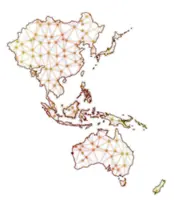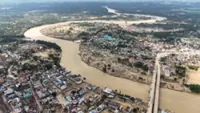Known as the ‘Blue Pearl of Siberia’, Lake Baikal is an iconic landmark. It is the world’s deepest freshwater lake and also the oldest (about 25 million years). — Photos: LEESAN
On July 16, 1969, the Apollo 11 spaceflight successfully launched into space from Cape Kennedy (now called Cape Canaveral), Florida in the United States. On July 20, astronauts Neil Armstrong and Buzz Aldrin, in a lunar module called Eagle, landed on the moon and stepped on the lunar surface, making global history.
This was when Armstrong said his most famous quote: “That’s one small step for man, one giant leap for mankind.”
That moment symbolised a great leap forward in the human exploration of the universe. More significantly, the spacecraft – carrying a total of three astronauts – returned to Earth successfully. It was a remarkable breakthrough in space technology, truly an unprecedented feat.
What many did not know, however, was that Armstrong later went to Siberia while on a visit to the (then) Soviet Union.
It is said that Armstrong stood silently for some time in front of a simple wooden building in Novosibirsk as if to offer his prayers. Reports say he picked up a handful of soil, carefully placed it into a bottle, and brought it back to the US.
It turns out that Armstrong was actually paying his respects to a man called Yuri Vasilyevich Kondratyuk, who once lived in the wooden house.
You may wonder who this person is.
Kondratyuk was a Soviet citizen born in Ukraine in 1897. He was a mathematical genius but due to the major wars (Russian Civil War, World War I, World War II) happening at the time, it was difficult for him to realise his full potential as an engineer.
But he still tried.
In 1929, while working as a mechanic he published a book called The Conquest Of Interplanetary Spaces, one of the first written proposals of a lunar orbit rendezvous (LOR) or in layman’s terms, travelling to the moon.
His work in this field was largely ignored at the time.
About 50 years later, Nasa announced that it was Kondratyuk’s LOR theory that solved the most critical technical problems in its own lunar missions. It was also this same theory that led to the success of the Apollo 11 mission, from its launch to the moon landing, and then its safe return to Earth.
We can probably say that Kondratyuk’s house in Novosibirsk was the actual “launch pad” of the 1969 lunar mission. I think Kondratyuk, who was posthumously recognised as a top Soviet engineer and mathematician, was the de facto pioneer in moon landing.
But back to Siberia. Some people say that this land is just a “geographical concept” with little practical significance. I beg to differ!
Siberia makes up a whopping 75% of Russia’s total land area, and plays a crucial part in the world’s civil history. Its extreme climate has given rise to a unique natural landscape endowed with rich natural resources. Its resilience also has far-reaching influence.
Siberia has, since time immemorial, been a precious land sought after by major powers. The many Chinese dynasties – particularly the Han, Tang, Yuan and Qing dynasties – as well as the Mongol Empire had all spread their influences in this land.
The evolution of history had not only left behind its traces, but also large-scale human migration, culminating in the flourishing of the Eurasian civilisation.
After the 16th century, Siberia became part of the Russian Empire. The exile system of Russia and the subsequent Soviet-era labour camps saw large numbers of people getting sent there to develop the vast land mass and build the world’s longest railway. This track, running 9,289km, is called the Trans-Siberian Railway and connects both Asia and Europe. It plays a vital role in global logistics and transportation.
Despite its size, Siberia houses a population of only about 40 million today, most of whom are Russians, with other ethnic minorities including Yakuts, Buryats (descendants of Mongolians), Evenks, and Khakass.
Their diverse languages, cuisines, traditions and beliefs, such as shamanism and Tibetan Buddhism, form Siberia’s unique Eurasian cultural fabric.
Notably, Siberia is also rich in natural resources – oil, natural gas, and coal, among others – which are the lifeblood of the Russian economy. These resources are an important means of international diplomacy, and have a major impact on the global energy supply.
That said, massive wealth disparity is evident in this vast, resource-rich land mass.
Most of the 60,000 plus people in Irkutsk, one of the largest cities in Siberia, generally believe that the central government has long ignored local development. Its antiquated airport is plagued with outdated Soviet-era facilities.
The centuries-old wooden houses lining the streets are charming but in a state of disrepair due to chronic disuse. Road traffic is chaotic, while urban development is frail, with hardly any investment to bolster the local economy.
That said, our charming Russian guide Katya has her own views on things. She said that despite the slow development, the cultural heritage in Siberia has been impeccably preserved. According to her, most tourists love to learn more about local lifestyles.
Siberia’s Oymyakon Village, known as the “Pole of Cold” is the coldest permanently inihabited village on Earth, while Yakutsk is the coldest city in the world. The lowest temperature at Yakutsk ever recorded was -64.4°C in February 1891! Coincidentally, we were also there in February, but thankfully the coldest it got was “only” -29°C.
Our group of 16 lay down on the frozen Lake Baikal, and felt the echoes faintly resonating under the ice. We listened to Katya sing Li Jian’s By The Lake Baikal, her melodious voice aptly embodied the soul of the song.
Right then someone in the group raised a bottle of vodka in his hand and asked out loud, “I have vodka. Who has a story to share?”
Yes, this is the Siberia that I know, the “forgotten” land that abounds with legends and stories, waiting to be explored.
The views expressed here are entirely the writer’s own.
Leesan, the globe-trotting traveller who has visited 147 countries and seven continents, enjoys sharing his travel stories and insights. He has also authored six books.







